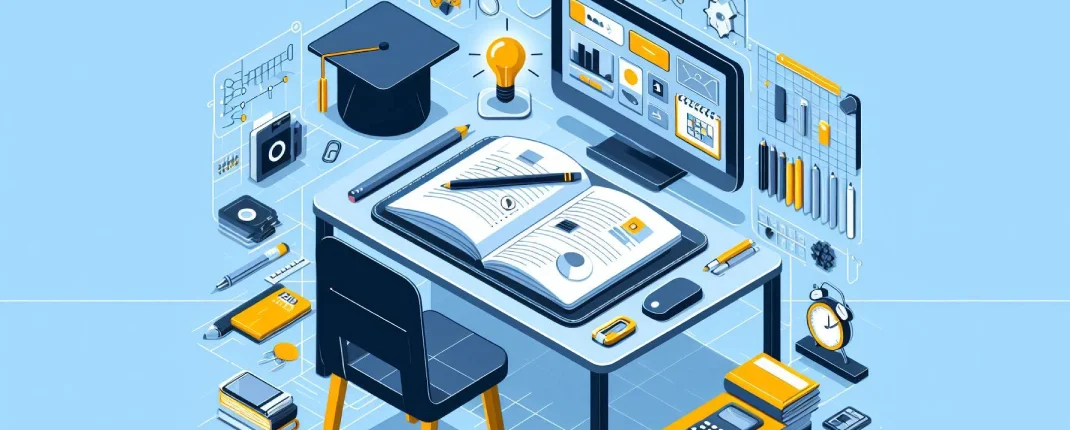
Anchal Sharma
4 min read
Introduction
In the rapidly evolving digital landscape, e-learning has emerged as a transformative force in education. With the increasing accessibility of smartphones and tablets, learners of all ages and backgrounds can now access educational content anytime, anywhere. To capitalize on this growing demand, businesses and educational institutions are recognizing the need for robust and engaging e-learning platforms.
Developing an e-learning app is a complex undertaking that requires a thorough understanding of pedagogical principles, user experience design, and technological capabilities. This comprehensive guide will provide you with all the essential information you need to navigate the e-learning app development process successfully. From identifying the key features and functionalities to choosing the right development platform and monetization strategy, we will cover everything you need to know to create a best-in-class e-learning app that empowers learners and drives business success.
What is an E-learning App Development?

E-learning app development refers to the process of creating digital platforms or applications for educational purposes. These apps are designed to deliver online learning experiences, providing users with access to course materials, interactive tools, and virtual classrooms. They are developed using various technologies and programming languages, and can be accessed on different devices such as smartphones, tablets, and computers. E-learning apps have gained popularity in recent years due to their convenience and flexibility, allowing learners to access educational content anytime and anywhere. They also offer a more engaging and interactive approach to learning compared to traditional methods.
Benefits of E-learning App Development

In the modern era of technological advancements, e-learning apps have emerged as a transformative tool for education and training. These apps offer numerous benefits that make them an indispensable resource for learners and educators alike.
Here are some of the key advantages of e-learning app development:
-
Accessibility and Convenience
E-learning apps provide unparalleled accessibility, allowing learners to access educational content from anywhere with an internet connection. They eliminate geographical barriers and time constraints, making it possible for individuals to learn at their own pace and on their own schedule.
-
Personalized Learning
E-learning apps enable personalized learning experiences tailored to the individual needs of each learner. They offer adaptive learning platforms that track student progress, identify areas for improvement, and provide customized content and exercises. This approach enhances engagement and improves learning outcomes.
-
Enhanced Engagement and Interactivity
E-learning apps incorporate interactive elements such as videos, simulations, and quizzes to make learning more engaging and memorable. Interactive content keeps learners motivated and allows them to actively participate in the learning process.
-
Real-Time Communication and Collaboration
E-learning apps facilitate real-time communication between learners and educators through chat, video conferencing, and discussion forums. This enables collaboration, peer-to-peer learning, and a sense of community among learners.
-
Cost-Effectiveness
Developing and deploying e-learning apps can be significantly more cost-effective than traditional in-person training. They eliminate the need for physical infrastructure, transportation costs, and instructor fees. Additionally, e-learning apps can be reused and updated easily, reducing long-term costs.
-
Scalability and Flexibility
E-learning apps can be scaled up or down to accommodate varying numbers of learners. They can be easily adapted to different learning objectives, target audiences, and course formats. This flexibility makes them suitable for a wide range of educational and training purposes.
-
Data Analytics and Insights
E-learning apps provide valuable data and insights into learner engagement, performance, and progress. This data can be used to improve course content, identify areas for improvement, and personalize the learning experience for each student.
-
Accessibility for Individuals with Disabilities
E-learning apps can be designed to meet the accessibility needs of individuals with disabilities. They can incorporate features such as closed captions, text-to-speech, and alternative text descriptions to ensure that all learners have equal access to educational content.
Also Read : The Future of App Development In Canada : Emerging Technologies and Opportunities
Types of E - learning App Development

E-learning, or electronic learning, has become an increasingly popular method of delivering education and training. E-learning apps offer a convenient and flexible way to learn, and can be used by individuals of all ages and backgrounds. There are a variety of different types of e-learning apps available, each with its own unique features and benefits.
-
Synchronous E-Learning Apps
Synchronous e-learning apps allow learners to interact with each other and with the instructor in real time. This type of app is well-suited for delivering live lectures, webinars, and other interactive learning experiences. Synchronous e-learning apps typically require learners to have access to a computer with a webcam and microphone.
-
Asynchronous E-Learning Apps
Asynchronous e-learning apps allow learners to access learning materials and complete assignments at their own pace. This type of app is well-suited for delivering self-paced courses, tutorials, and other non-interactive learning experiences. Asynchronous e-learning apps typically do not require learners to have access to a computer with a webcam and microphone.
-
Blended E-Learning Apps
Blended e-learning apps combine synchronous and asynchronous learning elements. This type of app is well-suited for delivering courses that require both live interaction and self-paced learning. Blended e-learning apps typically require learners to have access to a computer with a webcam and microphone.
-
Mobile E-Learning Apps
Mobile e-learning apps are designed to be used on smartphones and tablets. This type of app is well-suited for delivering learning materials and experiences that can be accessed on the go. Mobile e-learning apps typically require learners to have access to a mobile device with an internet connection.
-
Game-Based E-Learning Apps
Game-based e-learning apps use games and game-like elements to deliver learning materials and experiences. This type of app is well-suited for delivering engaging and interactive learning experiences. Game-based e-learning apps typically require learners to have access to a computer or mobile device with an internet connection.
-
Virtual Reality (VR) E-Learning Apps
Virtual reality (VR) e-learning apps use VR technology to deliver immersive learning experiences. This type of app is well-suited for delivering training simulations and other experiences that require learners to interact with a virtual environment. VR e-learning apps typically require learners to have access to a VR headset and a computer or mobile device with an internet connection.
-
Augmented Reality (AR) E-Learning Apps
Augmented reality (AR) e-learning apps use AR technology to deliver learning materials and experiences that overlay digital information onto the real world. This type of app is well-suited for delivering training simulations and other experiences that require learners to interact with the real world. AR e-learning apps typically require learners to have access to an AR headset and a computer or mobile device with an internet connection.
Choosing the Right Type of E-Learning App

The type of e-learning app that is right for you will depend on the specific learning goals and objectives. If you need to deliver live lectures or webinars, then you will need a synchronous e-learning app. If you need to deliver self-paced courses or tutorials, then you will need an asynchronous e-learning app. If you want to combine live interaction with self-paced learning, then you will need a blended e-learning app. If you want to deliver learning materials and experiences that can be accessed on the go, then you will need a mobile e-learning app. If you want to deliver engaging and interactive learning experiences, then you will need a game-based e-learning app. If you want to deliver immersive learning experiences, then you will need a VR or AR e-learning app.
A Step-by-Step Guide for E-learning App Development
-
Step 1: Define Your Target Audience and Learning Objectives
- Identify the learners you aim to reach, their demographics, and their educational or training needs.
- Clearly define the learning objectives you want to achieve with your app.
-
Step 2: Choose a Development Approach
- Native Development:** Develop separate apps for each platform (iOS, Android, etc.) using specific programming languages and tools.
- Cross-Platform Development:** Create apps that run on multiple platforms using frameworks like React Native or Flutter.
- Web-Based Apps:** Build apps that can be accessed through a web browser, eliminating the need for app stores.
-
Step 3: Design the App Experience
- User Interface:** Design an intuitive and engaging user interface that enhances the learning experience.
- Content Delivery:** Determine the format of your content (text, videos, quizzes, etc.) and how it will be presented.
- Assessment and Tracking:** Integrate features for assessments, quizzes, and progress tracking to monitor learner progress.
-
Step 4: Develop the App
- Choose appropriate programming languages and technologies based on your development approach.
- Implement the user interface, content delivery, assessment, and tracking features.
- Test and debug the app thoroughly to ensure functionality and user experience.
-
Step 5: Deploy and Distribute the App
- Submit your app to app stores (if applicable) or host it on a web server.
- Provide clear instructions for users to download and install the app.
-
Step 6: Market and Promote the App
- Create marketing materials (website, social media, etc.) to promote your app.
- Reach out to potential users through various channels (email, webinars, partnerships).
- Leverage app store optimization (ASO) to increase visibility in app stores.
-
Step 7: Maintain and Update the App
- *Consistently roll out updates to address bugs, introduce fresh features, and enhance user satisfaction.
- Monitor user feedback and make improvements based on their suggestions.
- Ensure security updates are implemented as needed.
-
Additional Considerations
- Accessibility:** Ensure your app accommodates users with disabilities by following accessibility guidelines.
- Data Privacy:** Implement robust data privacy measures to protect user information.
- Gamification:** Incorporate gamification elements to increase learner engagement and motivation.
- Personalized Learning:** Tailor the learning experience to individual learners based on their progress and preferences.
Conclusion
In conclusion, e-learning app development represents a pivotal opportunity for both educators and businesses to revolutionize the way learning is delivered and consumed. With the increasing accessibility of digital devices and the demand for flexible learning solutions, the potential for growth and impact in this sector is immense.
Empower learners, drive engagement, and unlock the full potential of e-learning with Whiten App Solutions. Contact Us today to embark on your e-learning app development journey and transform the way education is delivered and experienced.
FAQs
-
What are the different types of e-learning app development platforms available?
- Native platforms (iOS, Android)
- Cross-platform platforms (React Native, Flutter)
- Learning management systems (LMS) like Moodle, Blackboard
-
How to choose the right e-learning app development company?
- Experience and portfolio
- Technical expertise
- Industry knowledge
- Communication and collaboration
- Cost and timeline
-
What are the cost considerations for developing an e-learning app?
- App development platform
- Features and complexity
- Development team size and location
- Marketing and promotion expenses
-
How to promote and market an e-learning app effectively?
- App store optimization (ASO)
- Content marketing and SEO
- Social media marketing
- Email marketing
- Partnerships and collaborations

